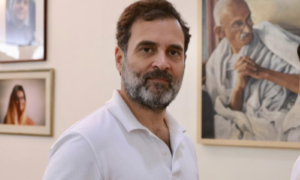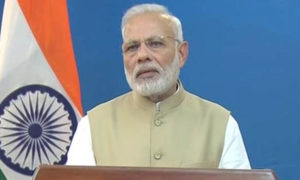After the BJP-led NDA government swept to power at New Delhi in 2014, a spike in cow vigilantism in the mainland India has gradually impacted the Kashmir-based leather industry and Bayt al-mals.
Just a furlong distance from Hurriyat patriarch Syed Ali Geelani’s Hyderpora residence, some five bearded men are sounding like doomsayers while deliberating on a loan case. After an hour long argument, they reluctantly pass Rs 1 lac against the applicant’s Rs 2.5 lac loan request.
“Let’s move to other applications,” Nazir Ahmad Dar, chairman of Syed Hyder Muslim Bayt al-mal (SHMB), gently tells the other men—the office-bearers—inside their office near Jamia Masjid Hyderpora, Srinagar.
On 17th of every month, the SHMB members sit to deliberate on loan applications and sanction monthly financial assistance to more than 20 households, including widows, orphans, handicapped and critically-ill persons, like cancer patients.
“Again this year,” Dar informs the meeting, “Bayt al-mal [‘House of money’] is short of funds. So, it’s not possible to approve all the applications for Qarz-e-Hasna.”
Qarz-e-Hasna is an interest-free loan, which the Bayt al-mal has been providing to needy people from last more than 25 years now.

Members Syed Hyder Muslim Bayt al-mal
But now, the local charitable body is staring at the grim picture.
From last three years, the Bayt al-mal is running short of funds. And the main reason behind it, is the drastic fall in the prices of the sacrificial animal hides — one of its main sources of income.
“The fall in the prices of animal hides from last three years has badly affected the consistency and backup plan of Bayt al-mal,” Dar says, sounding perturbed. “This cannot be neglected anymore!”
In last three years, the prices have plummeted from Rs 400 to Rs 30 for a single sheep or goat skin.
Such a disquieting situation is prevalent in other parts of the valley — where many Bayt al-mals surfaced soon after an overwhelming situation gripped Kashmir in early 90s, triggering a war-load in the form of orphans and widows.
In those harrowing days, such informal charitable institutes operating at locality level helped people—who remained out of work and income for days together—to sustain the vicious phase, and thus helped in averting the crisis triggered by continuous clampdown, curfews and crackdowns.
After 2008, when the street uprisings and subsequent state backlash forced the defiant population indoors and out of work for months together, many of these Bayt al-mals chipped in with emergency assistance. Even during the 2014 flood, scores of these local charitable bodies helped in tackling the crisis. Again in 2016, several Bayt al-mals would be frequented by needy section of society to get relief.
Much of their income would traditionally come through the animal hides — bulk of which would be pooled and traded in the Old City’s Aali Kadal, where traditional tanners would treat them before sending them outside the state — especially in Uttar Pradesh for full leather finishing.
“But the forced closure of many leather processing factories in UP and other parts where our exported raw animal hides would go for modifications and polishing has badly hit our business,” says Ajaz Ahmad, a well-known leather merchant from Aali Kadal. “It has drastically affected the entire trade, leading to a steep fall in prices of animal hides.”
After the organized attacks on Muslim cow transporters escalated across India with the advent of BJP government at Delhi in May 2014, many leather processing units—especially in Yogi Adityanath-ruled Uttar Pradesh—were put under lock and key in the face of raids by cow vigilantes.

A dairy farmer Pehlu Khan became the victim of cow vigilantism in Alwar, Rajasthan
“These attacks have already disturbed the entire demand-supply chain and impacted the Bayt al-mals and seminaries — for whom, the animal hides would be a big source of income,” Ajaz says.
Apart from the routine collections of animal hides from the local slaughter houses, Bayt al-mals would collect a bulk of them on the eve of Eid ul Azha, when Muslims sacrifice animals—sheep, goat, cow, etc—as part of their religious obligation.
Although cow vigilantism remains at the heart of the crisis, many tend to blame the other factors behind the fall as well.
“The Gau Raksha campaign should have essentially generated more supplies from valley instead of damping it,” says Idrees ul Islam, a doctorate scholar at Kashmir University and a son of leather merchant, “because except Kashmir, many Indian cities were badly affected by the very campaign.”
The major problem, the scholar says, lies in the changing global market. “Big investors like USA, UK, Germany, Switzerland and others are now getting attracted to bulk, cheap and quality raw material from Pakistan, Bangladesh, Vietnam, etc. This, plus the panic created by Gau Rakshaks, has almost doomed the India’s leather industry.”
Now, this calls for some pressing innovation in current leather products, Islam says. “If nothing would be done at this stage to drive the business forward,” he says, “it will eventually doom it.”
In that wake, Kashmir’s buffer system in the form of Bayt al-mals, which so far has played its role in thwarting the crisis created by conflicting situation in Kashmir, might leave the restive population in the lurch.
And given how the local industry has so far responded to the entire crisis, it seems Bayt al-mals in Kashmir are easily being choked by cow vigilantism campaign in mainland India, either with some intent or pure accident.
That’s why the concerns at Hyderpora were alarming in nature, rather than any routine rumblings.
Like this story? Producing quality journalism costs. Make a Donation & help keep our work going.








